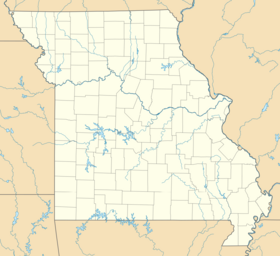Earth:Mastodon State Historic Site
| Mastodon State Historic Site | |
|---|---|
 Skeleton museum display | |
| Location | Jefferson County, Missouri, United States |
| Coordinates | [ ⚑ ] : 38°22′45″N 90°23′41″W / 38.37917°N 90.39472°W[1] |
| Area | 431.14 acres (174.48 ha)[2] |
| Elevation | 417 ft (127 m)[1] |
| Established | 1976[3] |
| Visitors | 677,188 (in 2022)[4] |
| Operator | Missouri Department of Natural Resources |
| Website | Mastodon State Historic Site Template:Infobox nrhp |
Mastodon State Historic Site is a publicly owned, 431-acre (174 ha) archaeological and paleontological site with recreational features in Imperial, Missouri, maintained by the Missouri Department of Natural Resources, preserving the Kimmswick Bone Bed.[5] Bones of mastodons and other now-extinct animals were first found here in the early 19th century. The area gained fame as one of the most extensive Pleistocene ice age deposits in the country and attracted scientific interest worldwide.
The site was purchased by the state in 1976 following an effort to preserve it from destruction with the construction of Interstate 55. Archaeological history was made at the site in 1979 when scientists excavated a stone spear point made by hunters of the Clovis culture (14,000–10,000 years ago) in direct association with mastodon bones. This was the first solid evidence of the coexistence of people and these giant prehistoric beasts.[6] The Kimmswick Bone Bed was added to the National Register of Historic Places in 1980.[7]
Activities and amenities
A museum tells the natural and cultural story of the oldest American Indian site one can visit in the state's park system. A full-size replica of a mastodon skeleton highlights the exhibits. A picnic area, hiking trails, and a special-use campground offer chances to explore the land where the lives of Native Americans and mastodons once intertwined.[5]
References
- ↑ 1.0 1.1 "Mastodon State Park". United States Geological Survey. https://geonames.usgs.gov/apex/f?p=gnispq:3:::NO::P3_FID:742921.
- ↑ "Mastodon State Historic Site: Data Sheet". Missouri Department of Natural Resources. November 2017. https://mostateparks.com/sites/mostateparks/files/mastodon_datasheet_01_2018.pdf.
- ↑ "State Park Land Acquisition Summary". Missouri State Parks. August 25, 2011. https://mostateparks.com/page/59045/state-park-land-acquisition-summary.
- ↑ "Missouri State Park Attendance For January - December, 2022". February 3, 2023. https://mostateparks.com/sites/mostateparks/files/MSP-Cumulative-Attendance-2022.pdf.
- ↑ 5.0 5.1 "Mastodon State Historic Site". Missouri Department of Natural Resources. December 10, 2010. https://mostateparks.com/park/mastodon-state-historic-site.
- ↑ "Mastodon State Historic Site: General Information". Missouri Department of Natural Resources. February 6, 2011. https://mostateparks.com/page/54983/general-information.
- ↑ "Kimmswick Bone Bed". NPGallery. National Park Service. https://npgallery.nps.gov/AssetDetail/NRIS/80002371.
External links
- Mastodon State Historic Site Missouri Department of Natural Resources
- Mastodon State Historic Site Map Missouri Department of Natural Resources
 |



